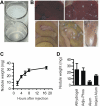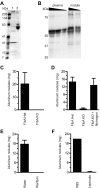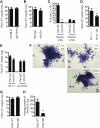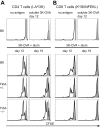Aluminum adjuvants elicit fibrin-dependent extracellular traps in vivo
- PMID: 20876456
- PMCID: PMC3012537
- DOI: 10.1182/blood-2010-03-275529
Aluminum adjuvants elicit fibrin-dependent extracellular traps in vivo
Abstract
It has been recognized for nearly 80 years that insoluble aluminum salts are good immunologic adjuvants and that they form long-lived nodules in vivo. Nodule formation has long been presumed to be central for adjuvant activity by providing an antigen depot, but the composition and function of these nodules is poorly understood. We show here that aluminum salt nodules formed within hours of injection and contained the clotting protein fibrinogen. Fibrinogen was critical for nodule formation and required processing to insoluble fibrin by thrombin. DNase treatment partially disrupted the nodules, and the nodules contained histone H3 and citrullinated H3, features consistent with extracellular traps. Although neutrophils were not essential for nodule formation, CD11b(+) cells were implicated. Vaccination of fibrinogen-deficient mice resulted in normal CD4 T-cell and antibody responses and enhanced CD8 T-cell responses, indicating that nodules are not required for aluminum's adjuvant effect. Moreover, the ability of aluminum salts to retain antigen in the body, the well-known depot effect, was unaffected by the absence of nodules. We conclude that aluminum adjuvants form fibrin-dependent nodules in vivo, that these nodules have properties of extracellular traps, and the nodules are not required for aluminum salts to act as adjuvants.
Figures







Similar articles
-
Mechanisms of stimulation of the immune response by aluminum adjuvants.Vaccine. 2002 May 31;20 Suppl 3:S34-9. doi: 10.1016/s0264-410x(02)00169-x. Vaccine. 2002. PMID: 12184362 Review.
-
Vaccine Adjuvants Differentially Affect Kinetics of Antibody and Germinal Center Responses.Front Immunol. 2020 Sep 23;11:579761. doi: 10.3389/fimmu.2020.579761. eCollection 2020. Front Immunol. 2020. PMID: 33072125 Free PMC article.
-
Polyphosphate nanoparticles enhance the fibrin stabilization by histones more efficiently than linear polyphosphates.PLoS One. 2022 Apr 25;17(4):e0266782. doi: 10.1371/journal.pone.0266782. eCollection 2022. PLoS One. 2022. PMID: 35468161 Free PMC article.
-
When an aluminium adjuvant is not an aluminium adjuvant used in human vaccination programmes.Vaccine. 2012 Mar 9;30(12):2042. doi: 10.1016/j.vaccine.2011.10.042. Epub 2011 Oct 30. Vaccine. 2012. PMID: 22041301 No abstract available.
-
[Aluminum as an adjuvant in vaccines and post-vaccine reactions].Rocz Panstw Zakl Hig. 1993;44(1):73-80. Rocz Panstw Zakl Hig. 1993. PMID: 8235346 Review. Polish.
Cited by
-
For Better or for Worse: A Look Into Neutrophils in Traumatic Spinal Cord Injury.Front Cell Neurosci. 2021 Apr 22;15:648076. doi: 10.3389/fncel.2021.648076. eCollection 2021. Front Cell Neurosci. 2021. PMID: 33967695 Free PMC article. Review.
-
Vaccine adjuvants: mode of action.Front Immunol. 2013 Jul 31;4:214. doi: 10.3389/fimmu.2013.00214. eCollection 2013. Front Immunol. 2013. PMID: 23914187 Free PMC article.
-
Squalene emulsion-based vaccine adjuvants stimulate CD8 T cell, but not antibody responses, through a RIPK3-dependent pathway.Elife. 2020 Jun 9;9:e52687. doi: 10.7554/eLife.52687. Elife. 2020. PMID: 32515732 Free PMC article.
-
Old and new adjuvants.Curr Opin Immunol. 2017 Aug;47:44-51. doi: 10.1016/j.coi.2017.06.005. Epub 2017 Jul 19. Curr Opin Immunol. 2017. PMID: 28734174 Free PMC article. Review.
-
A Biomimetic, Silaffin R5-Based Antigen Delivery Platform.Pharmaceutics. 2022 Dec 29;15(1):121. doi: 10.3390/pharmaceutics15010121. Pharmaceutics. 2022. PMID: 36678751 Free PMC article.
References
-
- Glenny AT, Pope CG, Waddington H, Wallace U. Immunological notes: XVII-XXIV. J Pathol Bacteriol. 1926;29:31–40.
-
- Glenny AT, Buttle GAH, Stevens MF. Rate of disappearance of diphtheria toxoid injected into rabbits and guinea-pigs: toxoid precipitated with alum. J Pathol Bacteriol. 1931;34:267–287.
-
- Suh TT, Holmback K, Jensen NJ, et al. Resolution of spontaneous bleeding events but failure of pregnancy in fibrinogen-deficient mice. Genes Dev. 1995;9(16):2020–2033. - PubMed
Publication types
MeSH terms
Substances
Grants and funding
LinkOut - more resources
Full Text Sources
Other Literature Sources
Molecular Biology Databases
Research Materials

